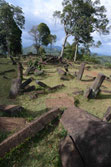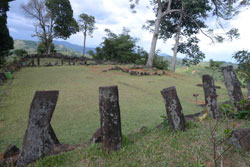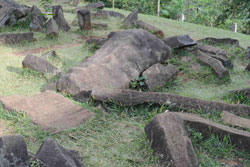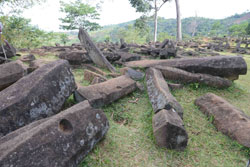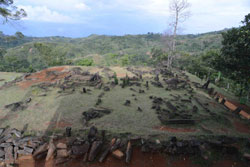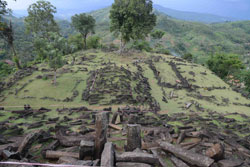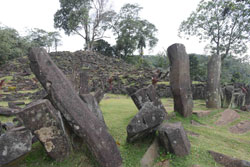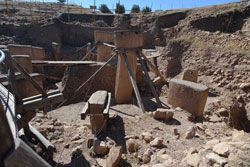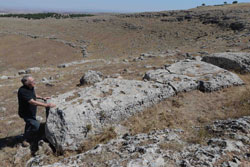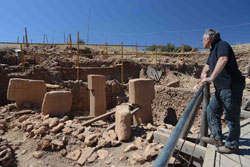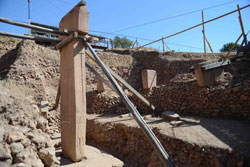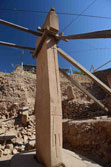|
I'm climbing with Dr Danny
Natawidjaja up the steep slope of a 300-ft high step-pyramid set
amidst a magical landscape of volcanoes, mountains and jungles
interspersed with paddy fields and tea plantations a hundred miles
from the city of Bandung in West Java, Indonesia.
Local people held the site to be sacred and called it Gunung Padang, the name it still goes by today, which means "Mountain of Light", or "Mountain of Enlightenment", in the local Sundanese language.
The summit, where the megaliths were found
arranged across five terraces had been used as a place of meditation
and retreat since time immemorial, archaeologists were told, and
again this remains true today.
By then the summit had long since been
cleared and the megalithic terraces recognized to be ancient and
man-made, but no radiocarbon dating was ever done and the previously
accepted age of the site - about 1,500 to 2,500 BC - was based on
guesswork rather than on excavations.
The dates produced - around 500 to 1,500
BC - were very close to the archaeological guesswork and caused no
controversy. However a surprise was in store as Natawidjaja and his
team extended their investigation using tubular drills that brought
up cores of earth and stone from much deeper levels.
Secondly the organic materials brought up in the drill cores began to yield older and older dates - 3,000 BC to 5,000 BC, then 9,600 BC as the drills bit deeper, then around 11,000 BC, then, 15,000 BC and finally at depths of 90 feet and more an astonishing sequence of dates of 20,000 BC to 22,000 BC and earlier...
The problem is that those dates from
9,600 BC and earlier belong to the period that archaeologists call
the "Upper Palaeolithic" and take us back deep into the last Ice Age
when Indonesia was not a series of islands as it is today but was
part of a vast southeast Asian continent dubbed "Sundaland" by
geologists.
But as the ice caps began to melt all the water stored in them returned to the oceans and sea-level rose, submerging many parts of the world where humans had previously lived. Thus Britain was joined to Europe during the Ice Age (there was no English Channel or North Sea).
Likewise there was no Red Sea, no Persian Gulf, Sri Lanka was joined to southern India, Siberia was joined to Alaska, Australia was joined to New Guinea - and so on and so forth.
It was during this epoch of sea-level
rise, sometimes slow and continuous, sometimes rapid and
cataclysmic, that the Ice Age continent of Sundaland was submerged
with only the Malaysian Peninsula and the Indonesian islands as we
know them today high enough to remain above water.
Around 4,000 BC the increasing sophistication of economic and social structures, and growing organizational abilities, made possible the creation of the earliest megalithic sites (such as Ġgantija on the Maltese island of Gozo for example) while the first true cities emerged around 3500 BC in Mesopotamia and soon afterwards in Egypt.
In the British Isles Callanish in the Outer Hebrides and Avebury in southwest England, both dated to around 3,000 BC, are the oldest examples of true megalithic sites.
The megalithic phase of Stonehenge is thought to have begun around 2,400 BC and to have continued to around 1,800 BC. Within this well worked out and long-established chronology there is no place for any prehistoric civilization such as Atlantis.
But interestingly the Greek philosopher Plato, whose dialogue of Timaeus and Critias contains the earliest surviving mention of the fabled sunken kingdom, dates the catastrophic destruction and submergence of Atlantis by floods and earthquakes to "9,000 years before the time of Solon" - i.e. to 9,600 BC, the end of the last Ice Age.
Since the Greeks had no access to modern scientific knowledge about the Ice Age and its rapidly rising sea levels (often accompanied by cataclysmic earthquakes as the weight of the melting ice caps was removed from the continental landmasses) the date Plato gives is, to say the least, an uncanny coincidence.
His research at
Gunung Padang has convinced him
that Plato was right about the existence of a high civilization in
the depths of the last Ice Age - a civilization that was indeed
brought to a cataclysmic end involving floods and earthquakes in an
epoch of great global instability between 10,900 BC and 9,600 BC.
In 10,900 BC, when it began, the earth had been emerging from the Ice Age for roughly 10,000 years, global temperatures were rising steadily and the ice caps were melting. Then there was a sudden dramatic return to colder conditions - even colder than at the peak of the Ice Age 21,000 years ago.
This short, sharp deep freeze lasted for 1,300 years until 9,600 BC when the warming trend resumed, global temperatures shot up again and the remaining ice caps melted very suddenly dumping all the water they contained into the oceans.
What has brought Natawidjaja to this radical view is the evidence he and his team have uncovered at Gunung Padang.
When their drill cores began to yield very ancient carbon dates from clays filling the gaps between worked stones they expanded their investigation using geophysical equipment - ground penetrating radar, seismic tomography and electrical resistivity - to get a picture of what lay under the ground.
The results were stunning, showing layers of massive construction using the same megalithic elements of columnar basalt that are found on the surface but with courses of huge basaltic rocks beneath them extending down to 100 feet and more beneath the surface.
At those depths the carbon dates indicate that
the megaliths were put in place more than 10,000 years ago and in
some cases as far back as 24,000 years ago.
The next step will be a full-scale archaeological excavation.
When I ask what he means by obstacles he replies that some senior Indonesian archaeologists are lobbying the government in Jakarta to prevent him from doing any further work at Gunung Padang on the grounds that they "know" the site is less than 5,000 years old and see no justification for disturbing it.
Gunung Padang is not the only ancient site that raises huge question marks over the story archaeologists tell us about our past.
On the other side of the world, in southeastern Turkey, another man-made hill has been excavated during the past decade, this time by Professor Klaus Schmidt of the German Archaeological Institute.
The site, called Göbekli Tepe (which means "Potbellied Hill" in the local Kurdish language) consists of a series of immense megalithic stone circles on the scale of Stonehenge and was deliberately buried (creating the appearance of a hill) around 8,000 BC by the mysterious ancient people who made it.
The circles themselves date back to 9,600 BC, however, with the oldest work being the best.
At least twenty further circles on a
similar scale, identified by ground penetrating radar, are still
deeply buried. Some of these, Klaus Schmidt told me when I
visited Göbekli Tepe in September 2013, are likely to be much older
than those already excavated.
I suggested there were survivors who settled at various locations around the world and attempted to pass on their superior knowledge, including knowledge of agriculture, to hunter-gatherer peoples who had also survived the cataclysm.
Indeed even today we have populations of
hunter gatherers, in the Kalahari Desert, for instance, and in the
Amazon jungle, who co-exist with our advanced technological culture
- so we should not be surprised that equally disparate levels of
civilization might have co-existed in the past.
Since 2007, however, masses of scientific evidence have come to light that have identified the smoking gun for me in the form of a comet that broke into multiple fragments now known to have hit the earth 12,980 years ago.
The impacts (some on the North American
ice cap, some elsewhere) caused floods and tidal waves and threw a
vast cloud of dust into the upper atmosphere that enshrouded the
entire earth for more than a thousand years, preventing the sun's
rays from reaching the surface, and setting off the Younger Dryas
deep freeze.
But it is to Gunung Padang that I now look for a possibly even more stunning confirmation of my theory.
Danny Natawidjaja's geological survey has revealed not only deeply buried massive constructions and very ancient carbon dates at Gunung Padang but also the presence of three hidden chambers, so rectilinear in form that they are most unlikely to be natural.
The largest of these lies at a depth of
between 70 and 90 feet beneath the summit of the pyramid and
measures approximately 18 feet high, 45 feet long and 30 feet wide.
If Dr Natawidjaja's geological excavation is allowed to proceed, despite strenuous attempts by local archaeologists to prevent it, then we should know the answer to that question, one way or another, by the end of 2014.
|




